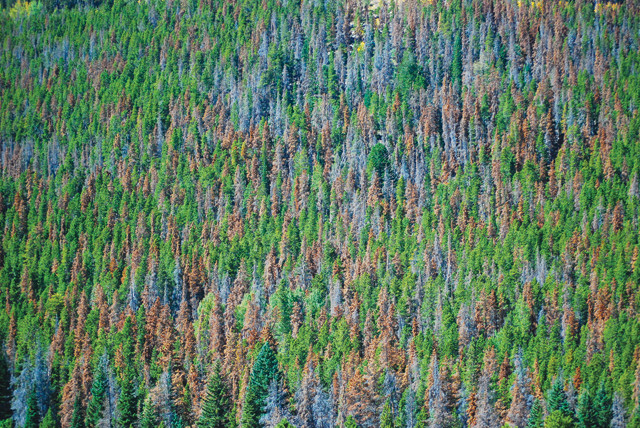
by Mary Caperton Morton Thursday, July 16, 2015

Bark beetles flourish in warm, dry conditions and have killed millions of hectares of pine forests in the western U.S. Credit: Don Becker, USGS.
Since the mid-1990s, outbreaks of voracious bark beetles have devastated more than 71,000 square kilometers of forests in the Rocky Mountain West. Contrary to popular belief, however, the huge swaths of standing dead trees left behind don’t necessarily pose an increased fire hazard, according to a new study. The finding calls into question the efficacy of recently enacted policies entailing the thinning of beetle-killed forests.
“A lot of [people involved in] policy and forest-management discussions are making the assumption that tree-kill by bark beetles is increasing the aggregate area burned by fires in the western U.S.,” says Tom Veblen, a forest and fire ecologist at the University of Colorado at Boulder and an author of the new study, published in Proceedings of the National Academy of Sciences. They’re making that assumption, he says, even though previous small-scale studies have suggested that standing dead trees don’t pose any more of an increased fire risk than live trees.
To assess the dangers of beetle-kill on a larger scale, Veblen, lead author Sarah Hart, also of the University of Colorado, and their colleagues overlaid U.S. Forest Service maps of regions affected by the mountain pine beetle — the species responsible for the most tree deaths in Colorado — with maps of acreage burned during the peak wildfire seasons of 2006, 2007 and 2012. They found that just 5 percent of the more than 100,000 square kilometers of forest that burned during those seasons had been attacked by beetles, indicating that the insects had not dramatically increased the total amount of land burned.
“This kind of study is important for helping policymakers and managers target the areas where it would be best to use our scarce resources,” Veblen says.
Combined with increasing rates of mountain pine beetle infestation, the burn statistics from these recent peak fire seasons, which account for half the acreage scorched by wildfires in the last 12 years in the western U.S., are driving current national policy, Veblen says. In 2014, Congress passed a new farm bill that allocated up to $200 million annually to combat insect and disease threats to trees on some 18 million hectares of public land, including extensive thinning programs to remove standing dead trees.
Veblen says he and his co-authors support some thinning in “appropriate areas” — near the forest-urban interface and homes, for example — but adds that, in remote areas, thinning due to beetle-kill “is really not justified.” It’s not just a matter of cost, Veblen says, “it’s also important to consider the impact of thinning operations on other resources, such as habitat for wildlife.”
By focusing only on total seasonal burn areas, however, the new study offers a limited view on the effects of beetle-killed trees on fire hazard, says Mike Jenkins, a forest ecologist at Utah State University, who was not involved in the new study. There are other factors to consider, he says, such as fire severity, heat intensity and the difficulty in controlling blazes.
“It’s pretty clear that bark beetle outbreaks modify forest fuels, and that beetle-killed forests will ignite more readily and burn differently,” Jenkins says. Lab-based studies and field observations suggest that beetle-killed trees can make forest fire flames more erratic, for example, and thus harder to contain, he says. “But whether [these effects are] expressed in the size of the fires — as they’ve analyzed — is another question.”
The study may prove useful in developing better fire-prediction models, Jenkins says. “Our current models were not designed for beetle-killed forests and do not adequately account for the kinds of changes that bark beetles can enact on forests.”
Veblen and his colleagues plan to continue studying interactions between bark beetles and fire behavior, also focusing on post-beetle-attack forest regeneration. “These insect disturbances are going to continue to happen,” Veblen says. “We need to focus on overall forest resilience in the face of climate change, because warming and drought are the primary reasons we’re seeing these extensive fires.”
© 2008-2021. All rights reserved. Any copying, redistribution or retransmission of any of the contents of this service without the expressed written permission of the American Geosciences Institute is expressly prohibited. Click here for all copyright requests.